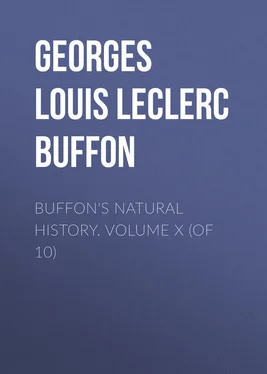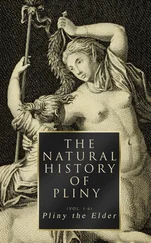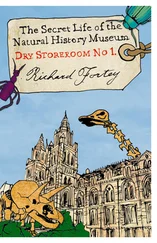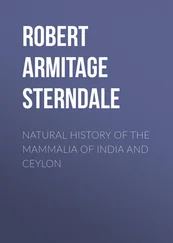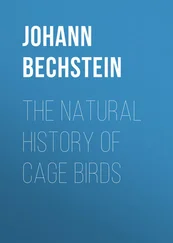Georges Buffon - Buffon's Natural History. Volume X (of 10)
Здесь есть возможность читать онлайн «Georges Buffon - Buffon's Natural History. Volume X (of 10)» — ознакомительный отрывок электронной книги совершенно бесплатно, а после прочтения отрывка купить полную версию. В некоторых случаях можно слушать аудио, скачать через торрент в формате fb2 и присутствует краткое содержание. Издательство: Иностранный паблик, Жанр: foreign_antique, foreign_prose, на английском языке. Описание произведения, (предисловие) а так же отзывы посетителей доступны на портале библиотеки ЛибКат.
- Название:Buffon's Natural History. Volume X (of 10)
- Автор:
- Издательство:Иностранный паблик
- Жанр:
- Год:неизвестен
- ISBN:нет данных
- Рейтинг книги:5 / 5. Голосов: 1
-
Избранное:Добавить в избранное
- Отзывы:
-
Ваша оценка:
- 100
- 1
- 2
- 3
- 4
- 5
Buffon's Natural History. Volume X (of 10): краткое содержание, описание и аннотация
Предлагаем к чтению аннотацию, описание, краткое содержание или предисловие (зависит от того, что написал сам автор книги «Buffon's Natural History. Volume X (of 10)»). Если вы не нашли необходимую информацию о книге — напишите в комментариях, мы постараемся отыскать её.
Buffon's Natural History. Volume X (of 10) — читать онлайн ознакомительный отрывок
Ниже представлен текст книги, разбитый по страницам. Система сохранения места последней прочитанной страницы, позволяет с удобством читать онлайн бесплатно книгу «Buffon's Natural History. Volume X (of 10)», без необходимости каждый раз заново искать на чём Вы остановились. Поставьте закладку, и сможете в любой момент перейти на страницу, на которой закончили чтение.
Интервал:
Закладка:
If we, in the same manner, enumerate the animals which are peculiar to the New World, we shall find, that there are about fifteen different species which may be reduced to ten genera and four detached species. These four species are the tapir, the cabiai, the lama, and the pecari; but there is only the tapir we can absolutely term detached; for the pecari has varieties; and the pacos may be united to the lama, and the Guinea hog to the cabiai. The ten genera are, 1. Eight species of sapajous. 2. Six species of sagoins. 3. The opossums, phalangers, tarsiers, &c. 4. The jaguars, couguars, ocelots, margais, &c. 5. Three or four species of coatis. 6. Four or five species of mouffettes. 7. The agouti genus, which comprehends the acouchi, the paca, the aperea, and the tapeti. 8. That of the armadillos, which consists of seven or eight species. 9. Two or three species of ant-eaters; and, 10thly, The sloth, of which we are acquainted with but two species.
Now these ten genera, and four detached species, to which the fifty species of animals peculiar to the New World may be reduced, though they differ from those of the Old Continent, nevertheless have some relations which seem to indicate some common affinity in their formation, and lead us to causes of degeneration, more ancient than any of the rest. We have already made the general remark, that all animals of the New World were much smaller than those of the Old. This great diminution in size, whatever maybe the cause, is a primary kind of degeneration, which could not be made without having a great influence on the figure of the animal, and we must not lose sight of this effect in comparing them together.
The largest is the tapir, which though not bigger than the ass, can only be compared with the elephant, rhinoceros, and hippopotamus; he claims the first place for size in the New Continent, as the elephant does in the Old. Like the rhinoceros, his upper lip is muscular and projecting; and, like the hippopotamus, he often enters the water. In some respects he represents them all three, and his figure, which partakes more of the ass than of any other animal, seems to be as degraded as his stature is diminished. The horse, the ass, the zebra, the elephant, the rhinoceros, and the hippopotamus, had no existence in America; neither was there an animal in this New Continent which could be compared with them, either with respect to size or figure. The tapir appears to have some affinity to the whale, but he is so mixed, and approaches so little to any one of them, that it is not possible to attribute his origin to the degradation of any particular species. And, notwithstanding these trifling relations which he is found to have with the rhinoceros, the hippopotamus, and the ass, we must look on him not only as a peculiar species, but even as a single genus.
The tapir, therefore, does not belong to any species of the Old Continent, and scarcely does he bear any characters which approximate him to those animals with which we have just been comparing him. The nature of the cabiai is likewise averse from our comparison: externally he has no resemblance with any other animal, and only approaches the Indian hog of the same continent, by his internal parts, and both species are absolutely different from all those of the Old Continent.
The lama and the pacos appear to have more significant marks of their ancient parents: the first with the camel, and the second in the sheep. The lama, like the camel, has a long neck and legs, slender head, and the upper lip divided. He resembles the latter also by his gentle manners, servility of disposition, endurance of thirst, and aptness for labour. This was the first and most useful domestic animal of the Americans: they made use of him to carry burdens, in the same manner as the Arabs do the camel. Here therefore are sufficient resemblances in the nature of these animals, to which we can yet add the permanent marks of labour; for though the back of the lama is not deformed by hunches like that of the camel, he, nevertheless, has callosities on his breast, occasioned by the like habit he is used to of resting on that part of his body. Yet, notwithstanding all these affinities, the lama is a very distinct and different species from the camel. He is much smaller, not exceeding a fourth or a third part of the camel’s magnitude. The shape of his body, and the quality and colour of his hair, are also very different. His temperament is still more so; for he is a phlegmatic animal, and delights only to live on the mountains, whereas the camel is of a dry temperament, and willingly inhabits the most scorching sands. On the whole, there are more specific differences between the camel and the lama, than between the camel and the giraffe. These three animals have many characters in common, by which they might be referred to one genus, but, at the same time, they differ so much in other respects, that we cannot suppose them to be the issue of one another; they are, therefore, only neighbours and not relations. The height of the giraffe is nearly double that of the camel, and the camel double that of the lama. The two first belong to the Old Continent, and form separate species. The lama, therefore, which is only found in the New, must be a distinct species from both.
It is not the same with respect to the pecari, for though a different species from the hog, he, nevertheless, belongs to the same genus. He resembles the hog in shape, and every external appearance, and only differs from it in some trifling characters, such as the aperture on his back, shape of the stomach, intestines, &c. We might, therefore, be led to suppose that this animal sprung from the same stock as the hog, and that he formerly passed from the Old World to the New, where, by the influence of the soil, he had degenerated to so great a degree as now to constitute a distinct species.
With regard to the pacos, though it appears to have some affinities with the sheep, in its wool and habit of body, yet it differs so greatly in every other respect, that this species cannot be looked on either as neighbours or allies. The pacos is rather a small lama, and has not a single mark which indicates its having passed from one continent to the other. Thus of the four detached species peculiar to the New World, three, namely, the tapir, the cabiai, and the lama, with the pacos, appear to belong originally to this continent, whereas the pecari, which forms the fourth, seems to be only a degenerated species of the hog, and to have formerly derived its origin from the Old Continent.
By examining and comparing, in the same manner, the ten genera, to which we have reduced the other animals peculiar to South America, we shall discover, not only singular relations in their nature, but marks of their ancient origin and degeneration. The sapajous and sagoins bear so great a resemblance to the monkeys, that they are commonly included under that name. We have proved, however, that their species, and even their genera, are different. Besides, it would be very difficult to conceive how the monkeys of the Old Continent could assume in America a different-shaped visage, a long, muscular, and prehensile tail, a large partition between the nostrils, and other characters, both specific and generic, by which we have distinguished and separated them from the sapajous. But as the monkeys, apes, and baboons, are only found in the Old Continent, we must look upon the sapajous and sagoins as their representatives in the New, for these animals have nearly the same form, as well externally as internally, and also have many things in common in their natural habits and dispositions. It is the same with respect to the makis, none of which are found in America, yet they seem to be represented there by the opossums, or four-handed animals, with pointed muzzles, which are found in great numbers in the New Continent, but exist not in the Old. We must, however, observe, that there is much more difference between the nature and the form of the makis, and of these four-handed American animals, than between the monkeys and the sapajous; and that there is so great a distance between the opossums and the maki that we cannot form an idea that the one ever proceeded from the other, without supposing that degeneration can produce effects equal to those of a new nature; for the greatest number of these American four-handed animals have a pouch under the belly, ten incisive teeth in each jaw, and a prehensile tail; whereas the maki has a flaccid tail, no pouch under the belly, and only four incisive teeth in the upper jaw, and six in the lower; therefore, though all these animals have hands and fingers of the same form, and also resemble each other in the elongation of the muzzle, yet their species, and even their genera, are so different, that we cannot imagine them to be one and the same issue, or that such great and general disparities have ever been produced by degeneration.
Читать дальшеИнтервал:
Закладка:
Похожие книги на «Buffon's Natural History. Volume X (of 10)»
Представляем Вашему вниманию похожие книги на «Buffon's Natural History. Volume X (of 10)» списком для выбора. Мы отобрали схожую по названию и смыслу литературу в надежде предоставить читателям больше вариантов отыскать новые, интересные, ещё непрочитанные произведения.
Обсуждение, отзывы о книге «Buffon's Natural History. Volume X (of 10)» и просто собственные мнения читателей. Оставьте ваши комментарии, напишите, что Вы думаете о произведении, его смысле или главных героях. Укажите что конкретно понравилось, а что нет, и почему Вы так считаете.
